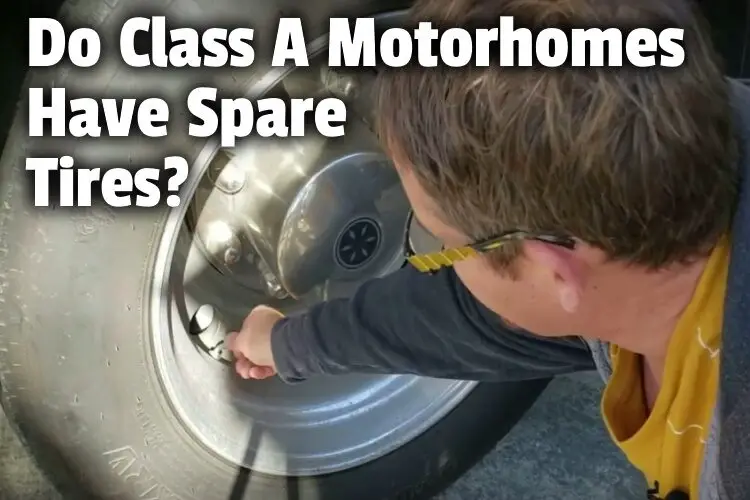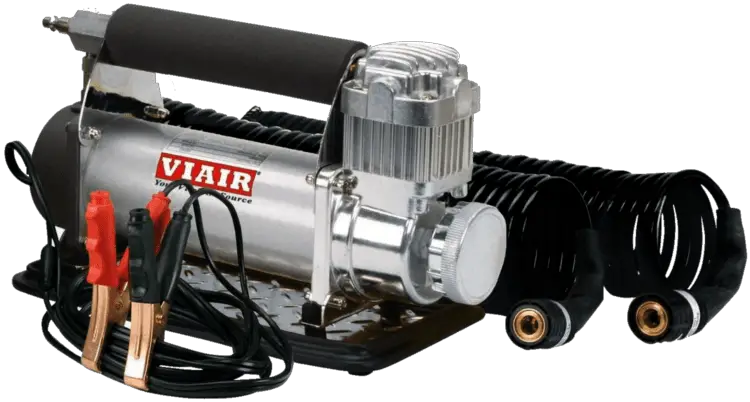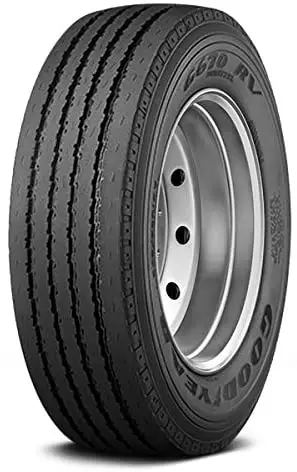When you first buy an RV, having only driven a car, it’s natural to wonder about maintenance. After all, we’re used to doing some of that ourselves like changing a flat tire. But RV tires can be really big, begging the question, do Class A motorhomes have spare tires?
Class A motorhomes do not come with spare tires, and the underside storage compartments are not typically large enough to hold one. However, it is possible to change a flat tire using the leveling jacks to raise the RV off the ground. But the spare tire itself would likely need to be carried inside the RV.
And an air gun would probably be necessary to remove the tire’s lug nuts. So honestly, if you have tire trouble on the road, it’s better to call roadside assistance than to do it yourself.
But that’s not all there is to know about Class A motorhomes and spare tires and flats on the road.
So in this article, we’ll look at all there is to know, including inside tires, if you can use fix-a-flat, and how much it costs to change an RV tire with a pro.
Just keep reading to learn more!

How many tires are on a Class A motorhome?
Most Class A motorhomes have 6 tires. Typically, there are 2 at the front and 2 on either side at the rear. Larger class A motorhomes will have 2 rear tires side by side, whereas smaller ones will have 1 in front of the other in the rear.
So the number of axles (and thus side by side wheels) depends largely on the weight.
Motorhomes will come with either one or two rear axles. Longer, heavier motorhomes are more likely to have dual rear axles.
If you get one with dual rear axles, the second one is there to just support the additional weight of the RV. This is known as a tax axle and will have a single-tier on either side.
The front axle of the dual rear axles will be the drive axle and have a total of four tires. Then, of course, you will have the front axle, which will have two tires.
But 6 tires are the most common configuration on Class A motorhomes.
The guys hard at work replacing tires on this RV! pic.twitter.com/gZYbMit3hG
— QueenCreek TirePros (@QueenCreekTire) December 1, 2017
How often should Class A motorhome tires be replaced?
Class A RV tires should be replaced at least every 5-8 years, even if they have not driven a lot of miles. The sun and extreme temperatures of either hot or cold can wear a tire out combined with the extreme weight of the RV, even if not frequently driven.
With your car or truck, your tires usually get replaced when they show signs of wear.
But RV tires do a lot more work than car or truck tires. They carry a lot more weight and a lot of safety risks if not properly maintained.
As they age, RV tires become much less safe.
While mileage is a factor, it shouldn’t be the only factor. If you haven’t been on the road in a while, but your tires are 6 or 7 years old, you should go ahead and replace them.
But there are some things you can do to extend the life of your tires. First, make sure they are always inflated properly. Consider installing a tire pressure monitoring system and carrying a portable air compressor on trips.
Keep them out of freezing or extremely hot temperatures. Use tire covers to block out damaging UV rays.
Tire covers are a small investment to increase the lifespan of your tires. They protect your RV tires from harsh elements, like the sun, which can cause a lot of damage.
To read more about how tire covers extend the life of your RV tires, check out this recent article. Even if you keep your tires covered, you will still need to keep them clean and inspected.
Just click the link to read it on my site.
Make sure your tires are always clean. Wash off any dirt and debris with soap and water at the end of each trip. While you’re washing them, check for any issues that could be cause for concern.
Finally, make sure you get them rotated on a regular basis.
That’s one way to rotate all 4 tires. https://t.co/P8Xt0dGcyO #rv #winter pic.twitter.com/EGU0oKDd2n
— RVupgrades.com (@RVupgrades) December 21, 2015
How often should you rotate motorhome tires?
Unlike cars and trucks, RV tires do not require regular rotation. This is because, unlike car and truck tires which get replaced as they wear out, RV tires typically get replaced long before they show significant signs of wear.
If you take good care of your RV’s tires and replace them regularly, you’ll likely replace them before they ever need to be rotated.
But there are a few things to look out for that might warrant a rotation.
Lookout for foreign objects lodged in the tread, cracks, and bulges in the sidewalls. Also, look for craving and weathering.
The front tires should always be checked for abnormal wearing patterns. To check, just rub your hand along the tread of the tire. While doing so, pay attention to problematic signs, like cupping or dipping.
Also, feel for feathering, which may be present if there is a misalignment.
You may also notice pulling in one direction while driving. If your motorhome is out of alignment, it will cause your tires to wear much faster.
Before you head out on the road, be sure to inspect your tires. Worn tires could blow out. I can’t think of anything scarier than having a blowout on the interstate!
On the rare occasion that a rotation is warranted, it may be that just the front tires need to be rotated. Oftentimes, different tires are used on different parts of the chassis, so rotating front to back isn’t an option.
One thing that is easy to do by yourself is to occasionally check and top off the tire pressure on your RV’s tires.
After all, most gas stations are hard to maneuver in, AND their air pumps probably can’t handle the PSI needed for RV tires (80 psi or above in most cases).
So, I carry one of these handy VIAIR 450P-RV tire compressors from Amazon in my RV. 
I just connect the jumper cables to either my coach or chassis batteries. Then I use the 60-foot cable to quickly and easily reach and top off all 6 tires.
It’s tiny, relatively quiet, easy to carry with 1 hand, comes in a handy carrying case, and easily stores in any of the compartments under the RV.
It can be set up in minutes, fills tires quickly (up to 150 psi), and includes multiple attachments for hard-to-reach tire stems and inside tires.
I check and top off my tires in minutes before every trip.
Did I mention it has well over 1,000 reviews, and virtually all of them are 5-stars? It’s also very small, so it fits easily in one of my smaller compartments on the outside of my RV.
CLICK HERE to see the current price on Amazon.
The #rvlife…so glamorous. Lol
Nothing serious going here, just changing out our own RV tires. We have a huge trip next week and we want to be ready. Wanna know what we are up to? Check out our latest YouTube video (Our RV Life is Changing AGAIN!!!!). … https://t.co/AKqdrvv70U pic.twitter.com/hHTNqctEui
— ExploringTheLocalLife (@ExplorLocalLife) March 1, 2019
Can you change the tire on a Class A motorhome yourself?
It is possible to change a Class A motorhome’s tires without taking them to a shop. It will require using the RV’s auto-leveling jacks to raise the RV and likely require an air gun and compressed air tank to remove the lug nuts.
But while it’s not necessarily difficult to change the tires, it could be dangerous.
You need to be able to safely lift the tire you’re changing completely off the ground. If the leveling jacks aren’t placed right, or the RV becomes unstable, it could come crashing down. This could cause a lot of unnecessary damage to your motorhome. It could be even worse if you were under the RV when it fell.
If you are considering living full-time in your motorhome, service calls are just one thing you’re going to have to think about.
RV living is great if you want to downsize and explore lots of places and climates.
To learn more about the pros and cons of full-time RV living, check out this recent article. I get into all the top things I learned from buying an RV and heading out for a month the next week. I also covered the 1 thing that cost me a lot.
Just click the link to read it on my site.
Lovin’ my seven* new @goodyear Endurance RV tires! #MadeInUSA
______
* includes spare tire pic.twitter.com/fKcw5o33I7— ⚡ Rob Rosenberger and 3,514 others (@rsnbrgr) January 29, 2019
What are the best Class A motorhome tires?
The Goodyear Unisteel G670 is one of the best tires for a Class A motorhome. While expensive, they have excellent stability over wet or dry surfaces. They also have outstanding grip and traction.
CLICK HERE to see the current price on Amazon AND arrange for professional installation.
Tires are a big cost of owning an RV. RV tires are anything but cheap, so you want to ensure that you get quality tires. They feel great when on the road. Their tough construction gives them exceptional tread life.
Another great tire is the Boto BT926. It’s a commercial truck tire that can withstand the weight of very large motorhomes.
It’s very stable on the highway and has excellent traction over wet surfaces. They are also tough and durable.
They are still pretty expensive, but really, most RV tires are. You want quality tires on your RV, which means a high price tag. You should expect to spend a minimum of $300 per tire for your RV.
But some can be as much as 3 times that. But this is not the time to pinch pennies.
RV tires are literally what keeps your RV going. You want to take care of them and keep them going for as long as possible, especially since they are so expensive.
Tire covers are a small investment to increase the lifespan of your tires. They protect your RV tires from harsh elements, like the sun, which can cause a lot of damage.
To read more about how tire covers extend the life of your RV tires, check out this recent article. What really surprised me was how much the color of the tire cover affects how well it protects the tires.
Just click the link to read it on my site.
Yep, I’d say that tire is done! #tire #tireblown #flattire #rv #rvlife #yikes #motorhome #newmexico #grateful #iloveyou https://t.co/lWzj8vg2Nr pic.twitter.com/foStuNk36z
— The Rebel 5 (@TheRebelFive) March 16, 2019
Can you use fix-a-flat on RV tires?
You can use fix-a-flat on RV tires, but only in an emergency situation where roadside assistance is not possible. Once the fix-a-flat has been used, immediately and slowly drive the RV to the nearest RV service shop and replace the tire.
Fix-a-flat should never be used as a permanent fix for RV tires.
CLICK HERE to get some on Amazon just in case you ever need it.
Most brands of fix-a-flat-type products use a propellant called R134A. Fix-A-Flat is a water-based product. And unfortunately, when R134A and water mix, they can become corrosive.
Over time, if you just fill the tire up with fix-a-flat and leave it alone, the rubber could be eaten away.
But also, fix-a-flat isn’t really designed for the high pressure associated with RV tires.
Remember that unlike car tires, which might have a max PSI of around 40-50, RV tires often have a max PSI of 80-150.
That’s a big difference, and the last thing you want is a blowout when you’re driving a 20,000-pound vehicle down the highway at 60 mph!
So stay on city roads or a frontage road and get to a tire shop (make sure they work on RVs as places like Discount Tire usually don’t these days) or RV service center ASAP.
CLICK HERE to get some Fix-a-Flat on Amazon for your emergency kit.
Final Thoughts
Manufacturers of Class A motorhomes want to make the most out of storage space. Tires are big and bulky and take up way too much space.
Class A motorhomes have a lot of length and weight, which means a lot of tires to take care of. Keep your tires clean, well maintained, and protected from the elements by using RV tire covers.
If you are unsure whether your tires need to be rotated, check with a professional.
Middle Class Dad is a participant in the Amazon Services LLC Associates Program, an affiliate advertising program designed to provide a means for sites to earn advertising fees by advertising and linking to Amazon.com. As an Amazon Associate, I may earn a small commission from qualifying purchases if you click to Amazon from my site and choose to make a purchase. This is no way increases the cost to you.

